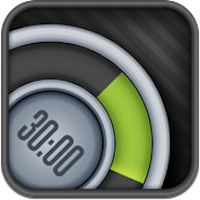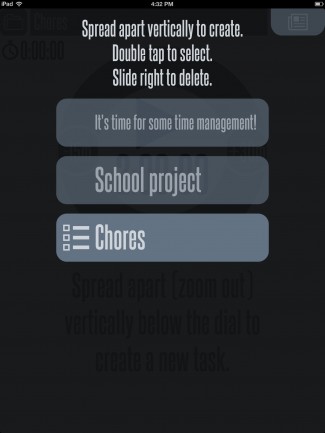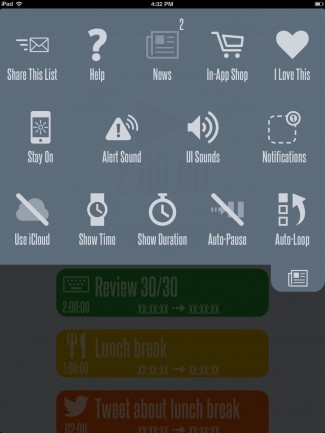Sue’s Focus Travels
LQ: 7.95
Recommended Age: 4+
Skills Used: Focus, Time Management, Mathematics, Writing

30/30 is an app designed to help users manage their time effectively and stay on task. The app facilitates the creation of timed and categorized tasks to help users keep track of how long they have dedicated to a particular project and when it is time to move on or take a break. Users can generate multiple task lists, which have the ability to run in a loop for projects that are repeated often. Additional features include vibrating and audible alerts when a task timer runs out, as well as intuitive touch and swipe features for adding and editing new tasks and categories. This app contains no inappropriate or adult content and is easy to use for anyone ages 6 and up.
Being efficient and aware of our use of time and effort.
 30/30 is a utility app designed to keep users on task and alert them when it is time to take a break or move on to a new project. Each task has a dedicated timer determined by the users. The app will alert users and automatically cycle to the next task on the list, moving the completed task to the bottom of the list. For example, if a user were to create a task list titled "Homework" with individual tasks titled "Work" and "Break" the application would cycle between each tasks timer, alerting the user when it was time to continue working and again when it was time to take a short break. This app is an excellent way to support users have difficulty staying on task or managing their time effectively between numerous tasks and responsibilities.
30/30 is a utility app designed to keep users on task and alert them when it is time to take a break or move on to a new project. Each task has a dedicated timer determined by the users. The app will alert users and automatically cycle to the next task on the list, moving the completed task to the bottom of the list. For example, if a user were to create a task list titled "Homework" with individual tasks titled "Work" and "Break" the application would cycle between each tasks timer, alerting the user when it was time to continue working and again when it was time to take a short break. This app is an excellent way to support users have difficulty staying on task or managing their time effectively between numerous tasks and responsibilities.
Developing a systematic approach for setting and achieving goals.
Utilizing 30/30 requires prioritization and foresight. Users must consider their tasks and responsibilities for a particular day or project and determine a reasonable amount of time to dedicate to each task. When creating a new list of tasks users have the ability to edit the timer, the color coding, and the symbols dedicated to each task making the app easy to understand. When working on a school project for example, users would need to exercise forethought in generating a workflow and task list. Additionally, each task requires a predetermined amount of time to be set on the clock. Receiving the greatest benefit and gaining productivity from 30/30 requires users to exercise the Planning thinking skill, systematically generating the steps toward achieving a particular goal.
30/30 is an excellent app for helping your child utilize the Time Management and Planning thinking skills. Try some of our suggested activities, or leave us your own ideas in the comment field at the bottom of the page.
 If your child has difficulty concentrating on a single task, or staying with a project from beginning to end, use 30/30 to time periods of work and occasional breaks. Set a timer that allows your child 45 minutes of uninterrupted work toward a single dedicated task. Your child should be sure to concentrate only on the task at hand for the duration of this timer. For each 45 minute block of work time, create a 10 or 15 minute block of "break time." Your child can use this time to have a snack, get some fresh air, or simply browse the web for unrelated topics. Spending some time away from the project can help your child's creativity and productivity when eventually returning to work. In addition, the break time can give your child some added incentive to work harder during the 45 minute work periods. Be sure to adjust the duration of the work and break periods to find a balance that works well with your child's particular needs.
If your child has difficulty concentrating on a single task, or staying with a project from beginning to end, use 30/30 to time periods of work and occasional breaks. Set a timer that allows your child 45 minutes of uninterrupted work toward a single dedicated task. Your child should be sure to concentrate only on the task at hand for the duration of this timer. For each 45 minute block of work time, create a 10 or 15 minute block of "break time." Your child can use this time to have a snack, get some fresh air, or simply browse the web for unrelated topics. Spending some time away from the project can help your child's creativity and productivity when eventually returning to work. In addition, the break time can give your child some added incentive to work harder during the 45 minute work periods. Be sure to adjust the duration of the work and break periods to find a balance that works well with your child's particular needs.
When your child is undertaking a new project that requires multiple steps or dedication to numerous tasks, utilize 30/30 to keep track of the workload. First, begin by plotting out the necessary steps or activities for completing the project. With your child, try to visualize how much time each task might possibly require. Try to be realistic and plan extra time for areas in which you are unsure or feel it might be necessary. Write these steps in the most logical order that will optimize productivity and efficiency. For example, when working on a science project for school, it would not be beneficial to begin working on the display board before completing the project's research. It is important that your child plan time to take a break, eat a healthy snack, or simply separate from the project for a few minutes. Doing so can often spur increased productivity, energy, and creativity upon returning to work.
 Children with ADHD may have trouble concentrating on a single task, or seeing a task through from beginning to completion. For these particular children, there may be a challenge simply getting started, organizing their materials, or staying on task without becoming distracted or bored. 30/30 is an excellent app for keeping users on task, especially a child who might display some of these difficulties. The app, which is based on the premise that users are more productive when working for 30 minutes and then breaking for 30 minutes, helps children with ADHD plan and mangage their time an optimized and efficient manner.
Children with ADHD may have trouble concentrating on a single task, or seeing a task through from beginning to completion. For these particular children, there may be a challenge simply getting started, organizing their materials, or staying on task without becoming distracted or bored. 30/30 is an excellent app for keeping users on task, especially a child who might display some of these difficulties. The app, which is based on the premise that users are more productive when working for 30 minutes and then breaking for 30 minutes, helps children with ADHD plan and mangage their time an optimized and efficient manner.
How to Use 30/30 for Children with ADHD:
30/30 is just one of many apps that can help users manage time, be productive, and stay on task. Try some of the suggested alternatives below and let us know which one works best for your needs in the comment field at the bottom of the page.
myTime Organizer is a similar app to 30/30, but is primarily designed for professionals. The app does have redeeming qualities for students, however, and contains mechanisms for keeping track of the amount of time dedicated to individual tasks. Learn more in our myTime Organizer review.
Astrid is an app that helps users plan ahead and stay organized. The app is light-hearted and effective to-do list which includes numerous features for helping users complete tasks and keep track of due dates and responsibilities. Find out more in our Astrid review.
The Scholastic Reading Timer is designed to help children and parents keep track of and improve reading habits. The app tracks reading time on a daily basis and compiles this information into a reading list and weekly reports for parents. Learn more in our Scholastic Reading Timer review.
All membership plans come with full access to our entire suite of tools learning guides, and resources. Here are a few of the ones we think you’ll like the most: